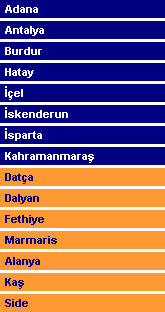| Kahramanmaras... |
|
Known as "Markasi" in earlies ages, this city, 78 km north of Gaziantep, stands as a site of history, having a
long past filled with numerous invasions, was once the capital of Gurgum, a Hittite State in the 12th century
BC. There exists an archaeological museum inside the citadel, where Hittite sculptures are on display. Other important
remains in the area are the Ulu Mosque and the Tats Medrese, both dating back to the 15th century, together
with the Hatuniye and Beyazit Mosques of the Ottoman period. This province, the original name of which was Maras, had
shown such valour during the War of Independence, that it was then given the title "Kahraman", which means of
"hero". The speciality of the region is its famous icecream well, and worth trying. Carved wooden furnitures,
copper and brass works and handworks of glided silver thread are also treasured. Caving, hunting, fishing beside plateaus
and picnicking areas are also famous. In the 12th century BC, Kahramanmaras was the capital of the Hittite state
of Gurgum. A massive citadel built in the 2nd century BC houses the city's museumand its good collection of
Hittite sculptures. Other sites include the 15th century Ulu Mosque and the Tas Medrese. The ice-cream of
Kahraman Maras, thickened with gum arabic and beaten with a wooden paddle, is known throughout Türkiye. Kahramanmaras has
been known as the city of lions since ancient times. Called as Maraksi in Assyrian sources, the city has been carrying the
same name of Kahramanmaras for at least 1500 years. According to a rumour, the name comes from the word 'mahris', which
means month abscess or year abscess. It is the name given to a a deep scar formed by the bite of a fly. As the excavations,
done around the city, unearthed many Hittite works, the city is thought to be a Hittite settlement. It was the capital city
of Gurgum state, which reigned after the Hittite Empire collapsed. Being ruled by Assyrians, Persians, Romans, Byzantines,
Arabs, Seljuks, Memlukians, and Dulkadirogullari succesively, it became part of the Ottoman Empire in the first half of the
seventeenth century. Named as Maras till 1973, it was donated the prefix 'Kahraman' which means 'heroic' after the city
resisted to French invasion under the leadership of Sutcu Imam. Maras Castle, situated on the hill in the center of the
city, is thought to be built in the firtst and second centuries.
|
|

|





